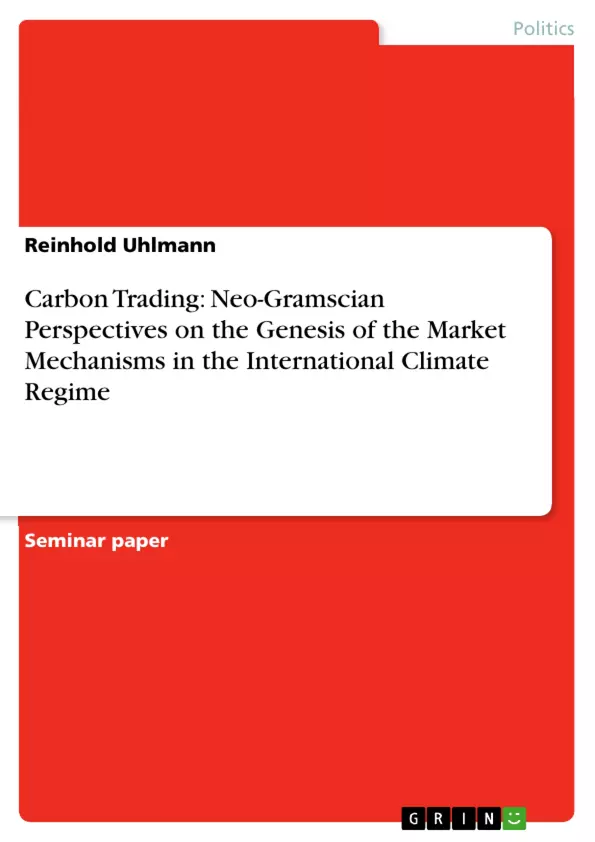This paper examines whether neo-Gramscian perspectives can explain the genesis of the three market mechanisms in the international climate regime, which are emissions trading, the Clean Development Mechanisms (CDM) and Joint Implementation (JI).
As far as I know no other article examined exactly this question before. After the description of the theory and a short introduction of these tools with their advantages and drawbacks, the history of the market mechanisms is explained in order to see whether the case goes hand in hand with the neo-Gramscian perspectives. The result is that these approaches can perfectly explain the genesis of the market mechanisms although a very little number of facts could maybe better explained with a governmentality approach.
Inhaltsverzeichnis (Table of Contents)
- Abstract
- Zusammenfassung
- Introduction
- Neo-Gramscian Perspectives
- The market mechanisms in the international climate regime
- Carbon trading in neo-Gramscian perspectives
- Conclusion
- References
Zielsetzung und Themenschwerpunkte (Objectives and Key Themes)
This paper investigates the applicability of neo-Gramscian perspectives to explain the emergence of three market mechanisms within the international climate regime: emissions trading, the Clean Development Mechanism (CDM), and Joint Implementation (JI). The paper aims to determine if these theories can effectively illuminate the genesis of these mechanisms.
- The genesis of market mechanisms in the international climate regime
- The role of neo-Gramscian perspectives in understanding climate change politics
- The impact of market mechanisms on global climate governance
- The advantages and drawbacks of emissions trading, CDM, and JI
- The historical development of market-based climate policies
Zusammenfassung der Kapitel (Chapter Summaries)
The paper begins with an overview of the neo-Gramscian theoretical framework, emphasizing its relevance to understanding the dynamics of climate change politics. It then introduces the three flexible mechanisms of the Kyoto Protocol: emissions trading, the Clean Development Mechanism, and Joint Implementation. The chapter discusses the advantages and disadvantages of these mechanisms, highlighting their potential implications for achieving climate targets. The next section examines the history of the market mechanisms, analyzing their emergence and development in relation to neo-Gramscian perspectives. The paper concludes by summarizing its findings and evaluating the usefulness of neo-Gramscian theories in explaining the evolution of market-based climate policies.
Schlüsselwörter (Keywords)
The core keywords of this paper include neo-Gramscian perspectives, market mechanisms, international climate regime, emissions trading, Clean Development Mechanism (CDM), Joint Implementation (JI), global governance, climate change politics, and hegemony. The paper focuses on the intersection of these concepts in understanding the genesis of market-based approaches to climate change mitigation.
- Quote paper
- Reinhold Uhlmann (Author), 2009, Carbon Trading: Neo-Gramscian Perspectives on the Genesis of the Market Mechanisms in the International Climate Regime, Munich, GRIN Verlag, https://www.grin.com/document/208953



